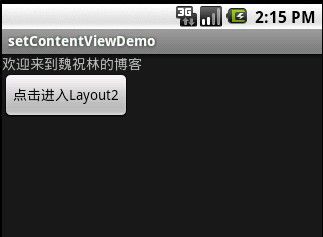Android初级教程十——手机页面的转换setContentView的应用
转载自令人敬佩的技术牛人http://blog.csdn.net/android_tutor/article/details/4811427
在网页的世界里,想要在两个页面间的转换,只要利用超链接就可以实现,
但是在手机的世界里,要如何实现手机页面的转换呢? 最简单的方法就是改变Activity 的Layout !
在这个例子中,将布局两个Layout ,分别为Layout1(main.xml) 和Layout2(mylayout.xml),
默认的Layout为main.xml,
我们在Layout1 当中创建一个按钮,当单击按钮时,显示第二个Layout(mylayout.xml) ;
同样地,在Layout2 里也设计一个按钮,当单击第二个Layout 的按钮之后,刚显示回原来的Layout1 ,
现在就来示范如何在两个页面之间互相切换.
首先看一下效果图(为了区别两个Layout ,我们分别设置了不同的背景色):
下面是我们本程序所涉及的相关代码,首先是主界面布局main.xml
<?xml version="1.0" encoding="utf-8"?>
<LinearLayout xmlns:android="http://schemas.android.com/apk/res/android"
android:orientation="vertical"
android:layout_width="fill_parent"
android:layout_height="fill_parent"
>
<TextView
android:layout_width="fill_parent"
android:layout_height="wrap_content"
android:text="欢迎来到魏祝林的博客"
/>
<Button
android:id="@+id/bt1"
android:layout_width="wrap_content"
android:layout_height="wrap_content"
android:text="点击进入Layout2"
/>
</LinearLayout>
其次我们在main.xml 同一目录新建一个为mylayout.xml 文件,代码如下:
<?xml version="1.0" encoding="utf-8"?>
<LinearLayout xmlns:android="http://schemas.android.com/apk/res/android"
android:orientation="vertical"
android:layout_width="fill_parent"
android:layout_height="fill_parent"
android:background="#ffffffff"
>
<TextView
android:layout_width="fill_parent"
android:layout_height="wrap_content"
android:text="Welcome to Mr Wei's blog"
/>
<Button
android:id="@+id/bt2"
android:layout_width="wrap_content"
android:layout_height="wrap_content"
android:text="点击进入Layout1"
/>
</LinearLayout>
最后是我们的核心程序setContentViewDemo.java
package com.android.setContentViewDemo;
import android.app.Activity;
import android.os.Bundle;
import android.view.View;
import android.widget.Button;
public class setContentViewDemo extends Activity {
public void onCreate(Bundle savedInstanceState) {
super.onCreate(savedInstanceState);
// 载入main.xml Layout
setContentView(R.layout.main);
// 以findViewById()取得Button对象并添加事件onClickLisener
Button bt1 = (Button) findViewById(R.id.bt1);
bt1.setOnClickListener(new Button.OnClickListener() {
public void onClick(View v) {
goToLayout2();
}
});
}
// 将layout由main.xml切换成mylayout.xml
public void goToLayout2() {
// 将layout改成mylayout
setContentView(R.layout.mylayout);
Button b2 = (Button) findViewById(R.id.bt2);
b2.setOnClickListener(new Button.OnClickListener() {
public void onClick(View v) {
goToLayout1();
}
});
}
// 将layout由mylayout.xml切换成main.xml
public void goToLayout1() {
setContentView(R.layout.main);
Button bt1 = (Button) findViewById(R.id.bt1);
bt1.setOnClickListener(new Button.OnClickListener() {
public void onClick(View v) {
goToLayout2();
}
});
}
}
最后执行.

